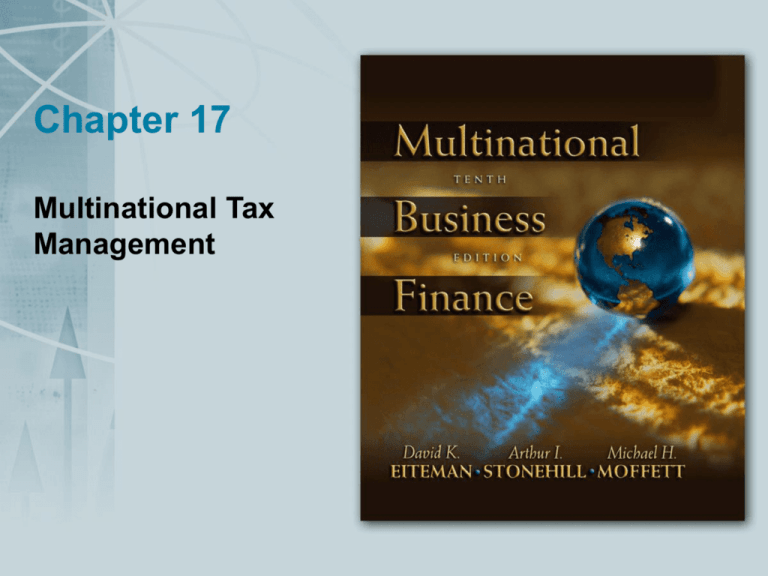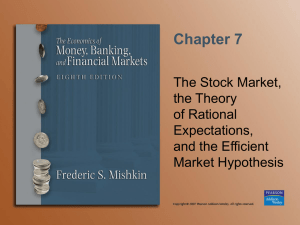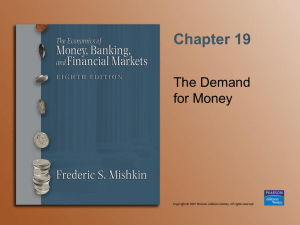
Chapter 17
Multinational Tax
Management
Multinational Tax Management
• Tax planning for multinational operations is an
extremely complex but vitally important aspect
of international business.
• To plan effectively, MNEs must understand not
only the intricacies of their own operations
worldwide, but also the different structures and
interpretations of tax liabilities across
countries.
• The primary objective of multinational tax
planning is the minimization of the firm’s
worldwide tax burden.
Copyright © 2004 Pearson Addison-Wesley. All rights reserved.
17-2
Multinational Tax Management
• Taxes have a major impact on corporate net
income and cash flow through their influence on
foreign investment decisions, financial structure,
determination of the cost of capital, foreign
exchange management, working capital
management, and financial control.
• Management must not pursue the objective of
minimizing the firm’s worldwide tax burden
without full recognition that decision making
within the firm must always be based on the
economic fundamentals of the firm’s line of
business.
Copyright © 2004 Pearson Addison-Wesley. All rights reserved.
17-3
Tax Principles
• Tax morality:
– In many countries taxpayers, corporate or
individual, do not voluntarily comply with the tax
laws
– The MNE must decide whether to follow a practice
of full disclosure to tax authorities or adopt the
philosophy “When in Rome, do as the Romans do”
– Most MNEs follow the full disclosure practice
Copyright © 2004 Pearson Addison-Wesley. All rights reserved.
17-4
Tax Principles
• Tax neutrality:
– When a government decides to levy a tax, it must consider not only
the potential revenue from the tax, or how effectively it can be
collected, but also the effect the proposed tax can have on private
economic behavior
– For example, the US government’s policy on taxation of foreignsource income has multiple objectives:
• Neutralizing tax incentives that favor or disfavor US private
investment in developed countries
• Providing an incentive for US private investment in developing
countries
• Improving the US BOP
• Raising revenue
Copyright © 2004 Pearson Addison-Wesley. All rights reserved.
17-5
Tax Principles
• One way to view neutrality is to require that the burden
of taxation on each dollar, euro, pound, or yen of profit
earned in home country operations by a MNE be equal
to the burden of taxation on each currency equivalent
of profit earned by the same firm in its foreign
operations (domestic neutrality).
• A second way to view neutrality is to require that the
tax burden on each foreign subsidiary of the firm be
equal to the tax burden on its competitors in the am
country (foreign neutrality).
• In theory, an equitable tax is one that imposes the same
total tax burden on all taxpayers who are similarly
situated and located in the same tax jurisdiction.
Copyright © 2004 Pearson Addison-Wesley. All rights reserved.
17-6
Tax Principles
• Despite the fundamental objectives of national tax
authorities, it is widely agreed that taxes do affect
economic decisions made by MNEs.
• Tax treaties between nations and differential tax
structures, rates, and practices all result in a less than
level playing field for the MNEs competing on world
markets.
• Nations typically structure their tax systems along one
of two basic approaches:
– The worldwide approach
– The territorial approach
Copyright © 2004 Pearson Addison-Wesley. All rights reserved.
17-7
Tax Principles
• The worldwide approach, also referred to as the residential
or national approach, levies taxes on the income earned by
firms that are incorporated in the host country, regardless
of where the income was earned (domestically or abroad).
• A MNE earning income both at home and abroad would
therefore find its worldwide income taxed by its home
country tax authorities.
• For example, a country like the US taxes the income
earned by firms based in the US regardless of whether the
income earned by the firm is domestic or foreign in origin.
Copyright © 2004 Pearson Addison-Wesley. All rights reserved.
17-8
Tax Principles
• The territorial approach, also termed the
source approach, focuses on the income earned
by the firms within the legal jurisdiction of the
host country, not on the country of firm
incorporation.
• Countries like Germany follow this approach
and apply taxes equally to foreign or domestic
firms on income earned within the country, but
in principle not on income earned outside the
country.
Copyright © 2004 Pearson Addison-Wesley. All rights reserved.
17-9
Tax Principles
• A network of bilateral tax treaties, many of which are
modeled after one proposed by the Organization for
Economic Cooperation and Development (OECD),
provides a means of reducing double taxation.
• Tax treaties normally define whether taxes are to be
imposed on income earned in one country by the
nationals of another, and if so, how.
• Tax treaties are bilateral, with the two signatories
specifying what rates are applicable to which types of
income between themselves alone.
Copyright © 2004 Pearson Addison-Wesley. All rights reserved.
17-10
Tax Principles
• Taxes are classified on the basis of whether
they are applied directly to income, called
direct taxes, or to some other measurable
performance characteristic of the firm, called
indirect taxes.
• Some categories include:
– Income tax
– Withholding tax
– Value-added tax
– Other national taxes
Copyright © 2004 Pearson Addison-Wesley. All rights reserved.
17-11
Tax Principles
• To prevent double taxation on the same
income, most countries grant a foreign tax
credit for income taxes paid to the host country.
• A tax credit is a direct reduction of taxes that
would otherwise be due and payable.
• If there were no credits for foreign taxes paid,
sequential taxation by the host government and
then by the home government would result in a
very high cumulative tax rate.
Copyright © 2004 Pearson Addison-Wesley. All rights reserved.
17-12
US Taxation of Foreign
Source Income
• As discussed, the US applies the worldwide
approach to international taxation to US MNEs
operating globally, but the territorial approach
to foreign firms operating within its borders.
• Dividends received from US corporate
subsidiaries are fully taxable in the US at US
tax rates but with credit allowed for direct taxes
paid on income in a foreign country.
Copyright © 2004 Pearson Addison-Wesley. All rights reserved.
17-13
US Taxation of Foreign
Source Income
• The amount of foreign tax allowed as a credit
depends on five tax parameters:
– Foreign corporate income tax rate
– US corporate income tax rate
– Foreign corporate dividend withholding tax rate for
nonresidents (per the applicable bilateral tax treaty)
– Proportion of ownership held by the US corporation
in the foreign firm
– Proportion of net income distributed (payout rate)
Copyright © 2004 Pearson Addison-Wesley. All rights reserved.
17-14
US Taxation of Foreign
Source Income
• If a US based MNE receives income from a foreign
country that imposes higher corporate income taxes
than the US (or combined income and withholding
tax), total creditable taxes will exceed US taxes on that
foreign income.
• The result is excess foreign tax credits.
• The proper management of global taxes is not simple,
and combines three different components:
– Foreign tax credit limitations
– Tax credit carry-forward/carry-back
– Foreign tax averaging
Copyright © 2004 Pearson Addison-Wesley. All rights reserved.
17-15
US Taxation of Foreign
Source Income
• Carlton Corporation is considering acquiring a
profitable telecommunications manufacturing
company in Brazil.
• The due diligence process includes an examination
of the tax implications of paying dividends to
Carlton from its existing subsidiary, Carlton
Germany, and simultaneously paying dividends to
Carlton from Carlton Brazil.
• The following exhibit summarizes the key tax
management issue for Carlton.
Copyright © 2004 Pearson Addison-Wesley. All rights reserved.
17-16
Exhibit 17.6 Carlton’s Tax Management
of Foreign-Source Income
Carlton Brazil
Carlton Germany
Pays corporate income taxes
in Brazil of 25%
Pays corporate income taxes
in Germany of 40%
Declares a dividend to its US parent
Declares a dividend to its US parent
Withholding taxes are deducted
from the dividend before leaving
Brazil of an additional 5%
Dividend remitted after-tax
Has paid less than US tax
requirement of 35% on income
Deficit Foreign Tax Credit
Efficient management
of Carlton’s foreign tax
position requires it to
try and balance
Deficit Foreign Tax
Credits against
Excess Foreign Tax Credits
Carlton
Pays corporate income taxes
in the United States of 35%
Pays taxes to US government separately on
domestic-source income & foreign-source income
Withholding taxes are deducted
from the dividend before leaving
Germany of an additional 10%
Dividend remitted after-tax
Has paid more than US tax
requirement of 35% on income
Excess Foreign Tax Credit
17-17
US Taxation of Foreign
Source Income
• The rule that US shareholders do not pay US
taxes on foreign-source income until that
income is remitted to the US was amended in
1962 by the creation of special Subpart F
income.
• The revision was designed to prevent the use of
arrangements between operating companies
and base companies located in tax havens as a
means of deferring US taxes and to encourage
greater repatriation of foreign incomes.
Copyright © 2004 Pearson Addison-Wesley. All rights reserved.
17-18
US Taxation of Foreign
Source Income
• Subpart F income is subject to immediate US taxation even when
not remitted.
• It is income of a type otherwise easily shifted offshore to avoid
current taxation and includes:
– Passive income received by the foreign corporation such as
dividends, interest, rents, royalties, net foreign currency gains, net
commodities gains, and income from the sale of non-incomeproducing property
– Income from the issuance of US risks
– Financial service income
– Shipping income
– Oil-related income
– Certain related-party sales and service income
Copyright © 2004 Pearson Addison-Wesley. All rights reserved.
17-19
US Taxation of Foreign
Source Income
• A MNE normally has a choice whether to organize a foreign
subsidiary as a branch of the parent or as a local
corporation.
• Both tax and nontax consequences must be considered.
• Nontax factors include the locus of legal liability, public
image in the host country, managerial incentive
considerations, and local legal and political requirements.
• A major tax consideration is whether the foreign subsidiary
is expected to run at a loss for several years after start-up.
• A second tax consideration is the net tax burden after paying
withholding taxes on dividends.
Copyright © 2004 Pearson Addison-Wesley. All rights reserved.
17-20
US Taxation of Foreign
Source Income
• Over the years, the US has introduced into US
tax laws special incentives dealing with
international operations.
• To benefit from these incentives, a firm may
have to form separate corporations for
qualifying and nonqualifying activities.
• The most important US special corporation is a
foreign sales corporation (FSC).
Copyright © 2004 Pearson Addison-Wesley. All rights reserved.
17-21
Exhibit 17.7 Foreign Sales Corporations (FSCs)
US
Manufacturer
Physical goods
Goods are sold on paper to its
Foreign Sales Corporation
located in the U.S. Virgin
Islands
European
Buyer
Foreign Sales Corporation
completes the sale by re-selling
the goods to the European Buyer.
Foreign Sales
Corporation
(U.S. Virgin Islands)
1. The payment by the European Buyer is routed through the FSC. The FSC may
charge the U.S. parent a commission, or simply pass the full payment on.
2. The tax benefits arise from the fact that up to 34% of the paper “profits” of the
resale are excluded from U.S. taxation.
3. When the FSC pays a dividend to its parent on its profits, the dividend is not taxed
by the U.S. tax authorities.
Copyright © 2004 Pearson Addison-Wesley. All rights reserved.
17-22
US Taxation of Foreign
Source Income
• The primary tax issues facing a US-based
MNE are:
– Domestic-source income and foreign-source income
are separated
– Foreign-source income is separated into active and
passive categories
– If the remittance of active income from one
subsidiary results in an excess foreign tax credit,
and the remittance from a second subsidiary results
in a foreign tax deficit, the credit may be applied to
the deficit if the incomes are of the same “basket”
under US tax law
Copyright © 2004 Pearson Addison-Wesley. All rights reserved.
17-23
Tax-Haven Subsidiaries and International
Offshore Financial Centers
• Many MNEs have foreign subsidiaries
that act as tax havens for corporate funds
awaiting reinvestment or repatriation.
• Tax-haven subsidiaries, categorically
referred to as international offshore
financial centers, are partially a result of
tax-deferral features on earned foreign
income allowed by some of the parent
countries.
Copyright © 2004 Pearson Addison-Wesley. All rights reserved.
17-24
Tax-Haven Subsidiaries and International
Offshore Financial Centers
• Tax-haven subsidiaries are typically established in a
country that can meet the following requirements:
– A low tax on foreign investment or sales income earned by
resident corporations and a low dividend withholding tax on
dividends paid to the parent firm
– A stable currency to permit easy conversion of funds into and
out of the local currency
– The facilities to support financial services activity
– A stable government that encourages the establishment of
foreign-owned financial and service facilities within its
borders
Copyright © 2004 Pearson Addison-Wesley. All rights reserved.
17-25
Exhibit 17.9 International Offshore Financial Centers
Copyright © 2004 Pearson Addison-Wesley. All rights reserved.
17-26








